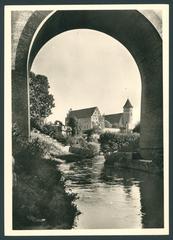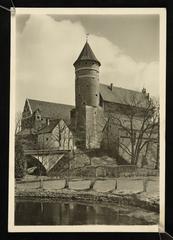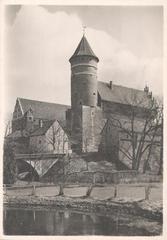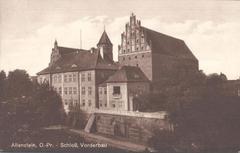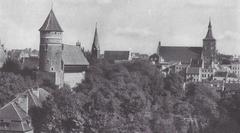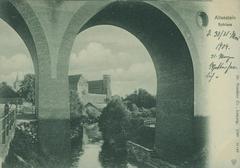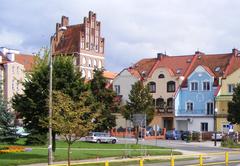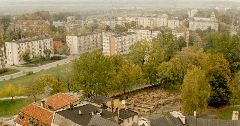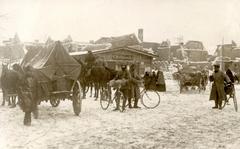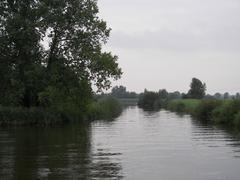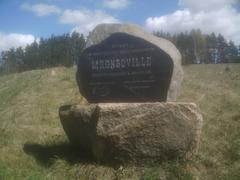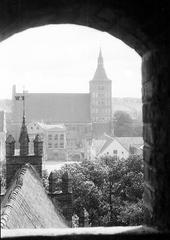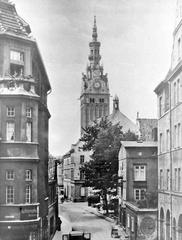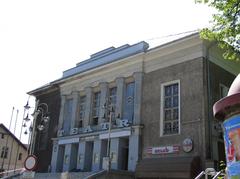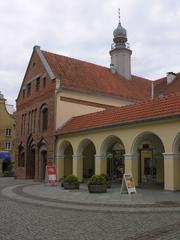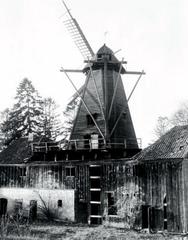
Castle of Warmian Bishops Olsztyn: Visiting Hours, Tickets, and Historical Sites Guide
Date: 14/06/2025
Introduction
Rising above the scenic banks of the Łyna River in northern Poland, the Castle of Warmian Bishops—also known as Olsztyn Castle—stands as a magnificent example of Brick Gothic architecture and a monument steeped in centuries of history. Built between 1346 and 1353 by the Warmian Cathedral Chapter, it originally served as both a fortress and an administrative hub, evolving over time into a Renaissance residence and, ultimately, the modern-day Museum of Warmia and Masuria. The castle’s storied past includes a close association with Nicolaus Copernicus, who managed its estates and conducted astronomical research within its walls. Today, visitors can explore its atmospheric halls, marvel at the Copernican astronomical plaque, and discover a wealth of exhibitions that celebrate the region’s heritage.
This comprehensive guide provides essential details for planning your visit—including Olsztyn Castle visiting hours, ticket information, accessibility, travel tips, and highlights of nearby attractions—ensuring an enriching experience for history enthusiasts, architecture aficionados, and curious travelers alike. For the latest updates, refer to the Museum of Warmia and Masuria website, Wikipedia, and The Trek Blog.
Table of Contents
- Introduction
- History and Significance
- Cultural Impact and Notable Events
- Practical Visitor Information
- Museum of Warmia and Masuria
- Frequently Asked Questions (FAQ)
- Conclusion and Further Resources
History and Significance
Origins and Construction
Olsztyn Castle was commissioned by the Warmian Cathedral Chapter in the mid-14th century, reflecting the region’s growing ecclesiastical and political influence (Wikipedia). The initial structure consisted of a single residential wing built on the north-east side of a rectangular courtyard, with robust walls, a moat, and a drawbridge enhancing its defensive capabilities (Wikipedia). Its strategic location complemented Olsztyn’s fortifications, integrating the castle into the city’s protective network.
Architectural Evolution
14th–15th Centuries
The castle expanded in the 15th century with the addition of a south-west wing and a distinctive tower, which rises 40 meters above the courtyard and remains an iconic feature of the Olsztyn skyline (Wikipedia). The defensive system was further strengthened with raised walls and an additional outer wall, ensuring the castle’s resilience during periods of conflict.
16th Century and Renaissance Changes
By the early 16th century, the castle’s military function had diminished, giving way to increased administrative and residential use. Bishop Łukasz Watzenrode oversaw the construction of new walls adapted for firearms, while the interiors were embellished with Gothic carvings and grand halls. The 15th-century chapel features vaulted ceilings and stained glass, emblematic of the era’s craftsmanship (PolskaBee).
Political and Military Roles
During its early history, Olsztyn Castle bore witness to the shifting alliances and power struggles that shaped Warmia. Though not under direct Teutonic rule, it was protected by the Teutonic Knights until the mid-15th century (The Trek Blog). The Thirteen Years’ War (1454–1466) saw Warmia, including Olsztyn, incorporated into the Kingdom of Poland, cementing its role as a key regional stronghold.
Copernicus and Scientific Heritage
Perhaps the most illustrious chapter in the castle’s history is its association with Nicolaus Copernicus. Serving as administrator between 1516–1519 and again in 1520–1521, Copernicus conducted significant astronomical research here. His 1517 astronomical table, drawn on a cloister wall, survives as a testament to his observations (The Trek Blog).
Later History and Modern Use
With the First Partition of Poland in 1772, Warmia was annexed by Prussia, and the castle’s administrative importance waned (Wikipedia). The 19th and 20th centuries saw extensive renovations—including major works between 1901 and 1911—and the tower’s current form was established in the 1920s. During WWII, the castle was damaged but survived. In 1945, it became the home of the Museum of Warmia and Masuria, safeguarding the region’s cultural legacy (Wikipedia).
Cultural Impact and Notable Events
The castle played a central role in several historic battles, including Polish-Teutonic clashes in the 16th century, and was adapted as a prison during the Partitions of Poland (PolskaBee). In modern times, it is a hub for cultural activity, hosting exhibitions, concerts, and the Olsztyn Artistic Summer festival, which draws visitors to its atmospheric halls (Wikipedia).
Practical Visitor Information
Visiting Hours
- April–October: Tuesday–Sunday, 10:00 AM – 6:00 PM
- November–March: Tuesday–Sunday, 10:00 AM – 4:00 PM
- Closed Mondays and public holidays
- For the most current hours, check the Museum’s official website
Tickets and Admission
- Adults: 20 PLN
- Students/Seniors: 10 PLN
- Children under 7: Free
- Family and group discounts available
- Additional fees for special exhibitions or guided tours may apply
- Tickets can be purchased onsite or online (Museum website)
Accessibility
The castle is partially accessible: ramps and elevators are present in key areas, but some upper floors and towers require stair access. Contact the museum in advance for assistance if needed.
Guided Tours
Guided tours (in Polish and by arrangement in English or German) are available for groups and individuals. Audio guides are offered in several languages. Advance booking is recommended, especially in peak season.
Nearby Attractions
- Old Town Market Square: Picturesque streets with cafes and shops
- St. James’s Cathedral: Gothic landmark
- Łyna River Promenade: Ideal for walks and scenic views
- Planetarium and Astronomical Observatory: For science enthusiasts
- Lake Ukiel: Recreation area nearby
Facilities & Amenities
- Modern restrooms (ground floor)
- Cloakroom and lockers
- Gift shop and café
- Family-friendly exhibits and workshops
- Non-flash photography permitted in most areas
Events and Seasonal Activities
- Historical reenactments and knight tournaments
- Concerts, cabaret, and art exhibitions
- Holiday workshops and family days
- Olsztyn Days Festival in summer
Travel Tips
- Best time to visit: Late spring or early autumn for pleasant weather and fewer crowds
- Dress code: Comfortable shoes recommended; some interiors may be cool
- Transport: Olsztyn is well-connected by train/bus to Warsaw and Gdańsk; airport 60 km away
- Parking: Limited near Old Town—public transport is recommended
Museum of Warmia and Masuria
Housed within the castle, the Museum of Warmia and Masuria presents extensive collections covering regional history, art, and science, including:
- Gothic and Baroque Artifacts: Religious and secular objects from the region’s history
- Copernicus Halls: Astronomical table, manuscripts, instruments
- Folk Culture and Ethnography: Traditional costumes and crafts
- Numismatics and Written Heritage: Coins, medals, rare manuscripts
The museum also hosts temporary exhibitions on contemporary art, regional themes, and educational workshops for all ages (Lonely Planet).
Frequently Asked Questions (FAQ)
Q: What are the Olsztyn Castle visiting hours?
A: April–October: 10:00–18:00; November–March: 10:00–16:00; closed Mondays.
Q: How much do tickets cost?
A: 20 PLN for adults, 10 PLN for students and seniors; discounts available.
Q: Is the castle accessible for disabled visitors?
A: Ground floor and some exhibits are accessible; contact the museum for details.
Q: Are guided tours available?
A: Yes; in Polish regularly, and in English/German by arrangement.
Q: Can I take photos?
A: Non-flash photography is generally allowed except in certain exhibitions.
Q: What else can I do nearby?
A: Visit Old Town, St. James’s Cathedral, the planetarium, and enjoy the river promenade.
Conclusion
Olsztyn Castle offers a compelling blend of medieval architecture, rich history, and vibrant cultural life. As the home of the Museum of Warmia and Masuria and a site deeply connected to Nicolaus Copernicus, it stands as a testament to the region’s enduring heritage. Whether you’re exploring its Gothic vaults, learning about Copernican science, or attending a cultural festival, the castle promises an unforgettable experience.
Plan your visit by consulting the Museum of Warmia and Masuria website, and enhance your journey with interactive guides and the Audiala app. Don’t miss the opportunity to discover one of Poland’s most treasured historical sites.
References
- Olsztyn - Wikipedia
- Trail of Teutonic Order Castles in Northern Poland – The Trek Blog
- Olsztyn Castle Historical Overview – PolskaBee
- Olsztyn Castle Historical Monument Listing – whitemad.pl
- Olsztyn Chapter Castle – medievalheritage.eu
- Museum of Warmia and Masuria – official site
- Museum of Warmia and Masuria in Olsztyn – Poland Travel Tours
- Museum of Warmia and Masuria – Lonely Planet
- Things to do in Olsztyn, Poland – travelodium.com
- Olsztyn Castle: Location and Access Guide – wildtrips.net
